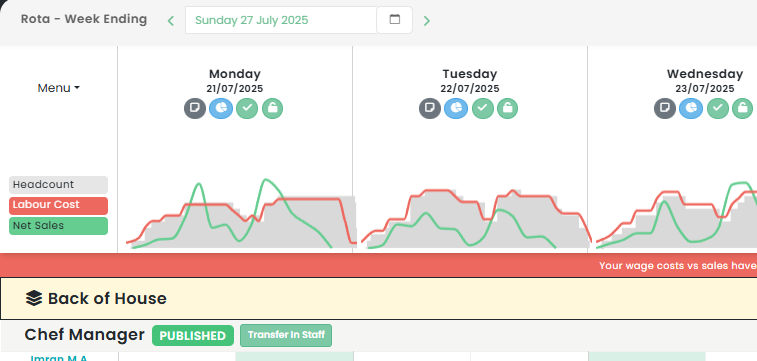Maximizing Your Restaurant Profit Margin: An Analysis of Average Restaurant Profits and Strategies to Boost Your Restaurant Business Revenue
Stay informed with industry news, tips, and practical guides for hospitality professionals.
Average Profit Margin for Restaurants in the UK: A Comprehensive Analysis
Understanding the financial dynamics of the hospitality industry, particularly the metrics surrounding restaurant profit margins, is crucial for restaurant owners and prospective investors. This article will delve into the average restaurant profit, restaurant industry profit, and profit margin in hospitality to furnish you with the knowledge you need to run a profitable restaurant.
Understanding Restaurant Profit Margin
The restaurant profit margin is a key indicator of the financial health of a restaurant. It represents the percentage of the restaurant revenue that is actual profit after all expenses have been deducted. Calculating this figure involves dividing the restaurant net profit by the total revenue and multiplying the result by 100.
Restaurant earnings differ greatly depending on various factors such as location, size, type of service, and menu pricing. However, according to industry data, the average restaurant profit margin in the UK ranges between 5% and 15%.
Maximising Restaurant Profit
Running a profitable restaurant involves a delicate balance between cost control, sales generation, and customer satisfaction. There are several strategies that restaurant owners can employ to maximise restaurant profit.
Firstly, effective inventory management is crucial. By actively monitoring and controlling food and beverage stocks, restaurant owners can reduce waste and lower food costs. Secondly, offering a well-designed, appealing menu can increase the average spend per customer, boosting restaurant business revenue. Lastly, providing exceptional customer service can enhance customer loyalty and encourage repeat business, thus driving up restaurant income.
Restaurant ROI and Profit Margin Analysis
Return on Investment (ROI) is another crucial metric for restaurant owners. It measures the profitability of an investment and provides a means to compare different investment opportunities. The restaurant ROI is calculated by dividing the net profit by the total investment and multiplying the result by 100.
Regular profit margin analysis can provide valuable insights into the financial performance of a restaurant. By comparing the current profit margin with previous periods, restaurant owners can identify trends, monitor progress, and make informed decisions to improve restaurant profitability.
The Impact of COVID-19 on the Food Service Profit Margin
The COVID-19 pandemic has significantly impacted the hospitality industry, leading to a decline in the average restaurant profit margin. However, many restaurants have adapted by pivoting to takeaway and delivery services, utilising digital technologies, and implementing stringent health and safety measures to reassure customers and maintain restaurant business revenue.
Conclusion
While the restaurant industry can be challenging and competitive, understanding key financial metrics such as the restaurant profit margin and ROI can help restaurant owners and investors make informed decisions. By focusing on maximising profit, regularly conducting profit margin analysis, and adapting to changing market conditions, running a profitable restaurant in the UK is certainly achievable.
Ready to simplify hospitality ops?
We’ve got you.
Speak with an Opsyte expert to see how we help:
- Save hours on staff scheduling and rota planning
- Automate invoice processing and financial insights
- Track live labour costs vs sales in real-time
- Get fast answers and support from real humans
- Automate your P&Ls

“Opsyte transformed our entire back office. Game changer.”
Read articles from our hospitality experts
-
Boosting Your Business: Innovative Bar Promotional Ideas and Marketing Strategies to Increase Sales and Traffic
10 Innovative Bar Promotional Ideas to Boost Your BusinessThe UK's hospitality industry is a vibrant and competitive space with bars and pubs at its heart. As a bar owner or…...
-
Maximising Efficiency in Hospitality: The Emerging Trends in Workforce Management, Scheduling, and Digital Transformation
Hospitality Workforce Management - Enhancing Efficiency in the UK Hospitality IndustryThe UK hospitality industry plays a significant role in the country's economy, contributing a substantial portion to the GDP. As…...
-
Boosting Guest Satisfaction: Effective Strategies for Enhancing Customer Experience in the Hospitality Industry
Enhancing Customer Experience in the UK Hospitality IndustryUnderstanding and improving the Customer Experience is pivotal in shaping the success of the UK's Hospitality Industry. With consumers' expectations constantly evolving, businesses…...
-
Maximising Customer Satisfaction: Comprehending and Implementing QSR Standards in the Quick Service Restaurant Industry
Understanding QSR Standards in the UK Hospitality IndustryQuick Service Restaurants (QSRs), colloquially known as fast-food outlets, have become vital components of the UK's hospitality industry. They offer a convenient, affordable…...
-
Revolutionizing the Nightlife: Innovative and Profitable Bar Business Ideas for the Hospitality Industry
Ideas for Bar Business: Fostering Success in the UK Hospitality IndustryThe UK hospitality industry is a vibrant and dynamic sector, offering an array of opportunities for bar entrepreneurship. A successful…...
-
Minimising Food Waste in Restaurants: A Comprehensive Guide to Sustainable Practices in the Hospitality Industry
How to Reduce Food Waste in Restaurants: A Guide to SustainabilityThe hospitality industry plays a significant role in the global sustainability mission, especially concerning food waste management. By focusing on…...
